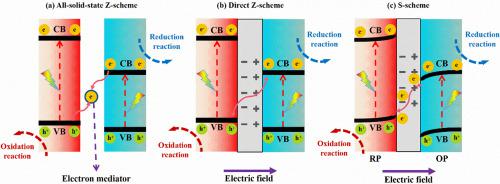Materials Today Energy ( IF 9.0 ) Pub Date : 2021-08-11 , DOI: 10.1016/j.mtener.2021.100829 Ye Yuan 1 , Rui-tang Guo 1, 2 , Long-fei Hong 1 , Xiang-yin Ji 1 , Zhi-dong Lin 1 , Zheng-sheng Li 1 , Wei-guo Pan 1, 2

|
Metal oxide-based Z-scheme heterojunction photocatalyst can effectually separate electrons and holes, and simultaneously ensure that photocatalysts can maintain appropriate conduction band and valence band positions, thus maintaining a strong redox capacity. This paper introduced the mechanism and types of Z-scheme heterojunction photocatalysts. Nevertheless, direct Z-scheme photocatalytic mechanism was gradually replaced by new S-scheme heterojunction mechanism. Thus, this review also briefly discussed the improved Z-scheme mechanism, that is, S-scheme heterojunction, so that the mechanism of the charge transfer process could be understood more intuitively and clearly. Then we emphatically summarized the applications of different types of heterojunctions in the field of photocatalysis, ranging from environmental remediation to energy conversion. In addition, several typical traditional methods and new strategies for preparing Z-scheme heterojunctions were summed up. Finally, the breakthrough and development prospect of Z-scheme heterojunction were discussed.
中文翻译:

基于金属氧化物的 Z 型异质结光催化剂综述:现状与发展
基于金属氧化物的Z-scheme异质结光催化剂可以有效地分离电子和空穴,同时保证光催化剂可以保持适当的导带和价带位置,从而保持很强的氧化还原能力。介绍了Z型异质结光催化剂的作用机理和类型。尽管如此,直接Z型光催化机制逐渐被新的S型异质结机制所取代。因此,本综述还简要讨论了改进的Z-scheme机制,即S-scheme异质结,以便更直观、更清晰地理解电荷转移过程的机制。然后重点总结了不同类型异质结在光催化领域的应用,从环境修复到能量转换。此外,总结了几种典型的制备Z型异质结的传统方法和新策略。最后讨论了Z型异质结的突破和发展前景。

































 京公网安备 11010802027423号
京公网安备 11010802027423号